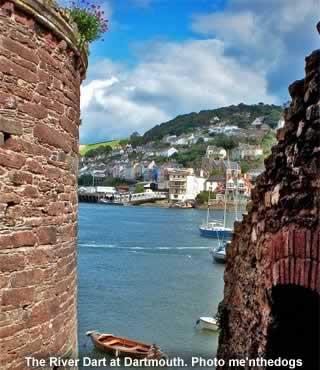Dartmouth |
|
 |
|||
A town in Devon with a strong nautical and naval history |
||
Listen to this article |
||
Dartmouth is a town in Devon with a strong nautical and naval history. It has been involved in many conflicts, including the Crusades, the Hundred Years War, and World War II. Nowadays though, it is a peaceful and relaxing place, full of sailing boats, ferries, and trawlers. |
||
Unsurprisingly, Dartmouth takes its name from being located at the mouth of the River Dart. The riverside is the focus of the town, with rows of beautiful old buildings looking out over the water. Around and above these houses are dozens of thick trees, which frame the scene perfectly. This promenade along the water's edge is called the Embankment, and it makes for Dartmouth's most iconic image. |
||
If you want to see the very beginning of the town's maritime history, head for Bayard's Cove, at the Embankment's southern end. This is the oldest part of the harbour, and remarkably, it has changed very little over the years. The cobbled quayside looks almost the same now as it did in the 16th century. This port provided a brief rest stop for the Pilgrim Fathers, who set off in 1620 to form a new community in the Americas. |
||
During these olden times, when Dartmouth still saw conflict on what must have seemed like a regular basis, it was protected by two castles. The biggest of these was Dartmouth Castle, which is still standing today. The first fort to be built on the site was completed in 1388, but the most recognisable developments took place in the 15th century, when the gun tower was built. This was one of the first coastal fortresses to use artillery guns, a great innovation at the time. The cannon on top of this tower had the power to sink ships. In later years, more guns were added, and the castle continued to see military use. It even played a part in World War II. The second of the two castles is Kingswear, on the opposite bank of the river. Formerly, a chain was stretched between the two castles at night, to prevent surprise attacks by enemy fleets. |
||
Despite Dartmouth's history of conflict, many old and interesting buildings are still standing. The most well known example is the Butterwalk, a house of traditional 16th century Tudor design, with that classic black and white exterior. King Charles II once held court here, when a fierce storm prevented his ship from setting sail. The building is now home to the Dartmouth Museum, which contains many local artefacts, as well as a large collection of ships in bottles! |
||
Dartmouth's nautical and military traditions are carried on at the Britannia Royal Naval College, which trains new officers for the Navy. The college is housed in an elegant building that overlooks the town. It has been running for over a century, and has educated several royal family members. It's even rumoured that this is where Prince Philip met Queen Elizabeth for the first time! |
||
To get a glimpse of the town in all its previous glory, at the peak of its life as a busy harbour, then make a visit during the Regatta. The Port of Dartmouth Royal Regatta, to give it its full name, takes place every August, and features sailing, rowing, fireworks displays, and even an exhibition from the Red Arrows. |
||
|
||
Dartmouth Tourist Information Centre, The Engine House, Mayor's Avenue, Dartmouth TQ6 9YY. Tel: 01803 834224 |
||
Dartmouth Castle is open daily April to October, 10am to 5pm (plus limited winter opening). Entry costs around £6 for adults, £3 children. Castle Road, Dartmouth TQ6 0JN. Tel: 01803 833588 |
||
|
Pocket Britain is optimised for use on a smartphone or tablet with internet access. All content is subject to copyright. All reasonable methods have been used to ensure information supplied is accurate at the time of publication. However, it is advisable to check information before relying on it. Privacy Policy |